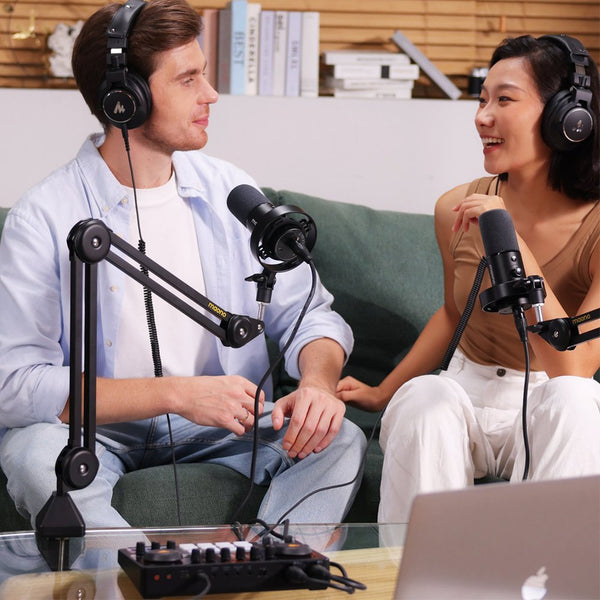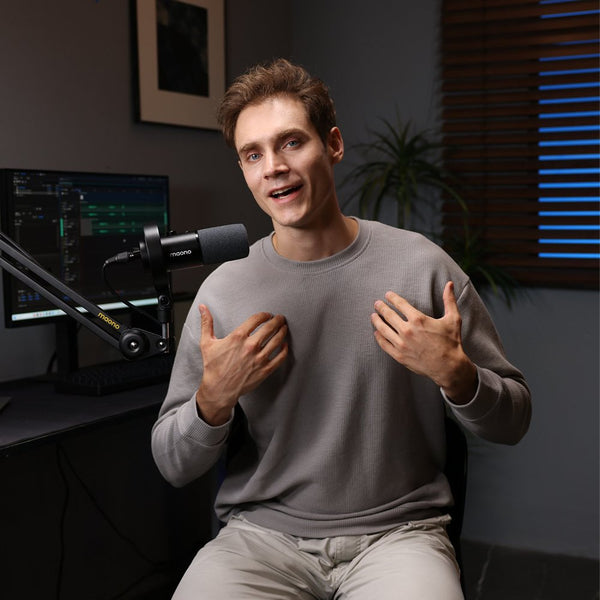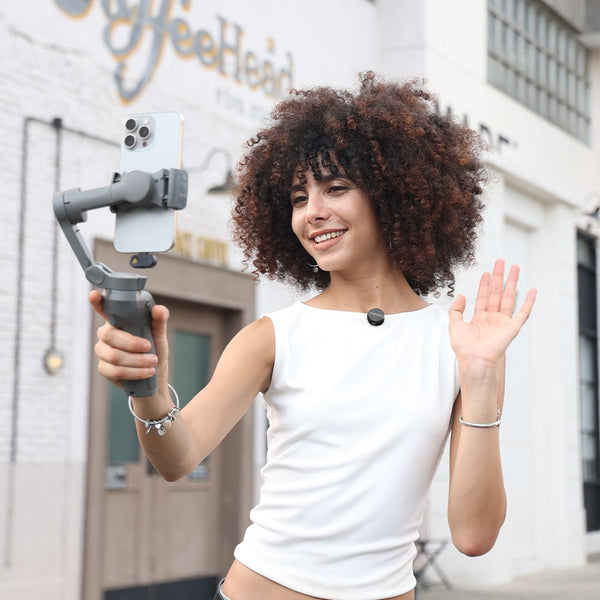How to Create Pro-Level Workplace Interview Videos with Your Phone
Are you a vlogger or a journalist? If so, you know that not all lavalier wireless microphones are compatible with both Android and iPhone. Amazingly, Maono offers wireless microphones that are compatible with both platforms—the Maono Wave T5 and Maono Wave T1 Mini wireless microphone options.
Introduction: Choosing the Right Wireless Mic for Mobile Journalism
In today’s fast-paced digital landscape, mobile journalism and content creation are no longer limited to high-end camera gear. Smartphones have evolved into powerful tools capable of capturing broadcast-quality video. However, one critical element still makes or breaks your production: sound quality.
Whether you're a journalist, corporate communicator, educator, or social media content creator, using a wireless microphone with your smartphone significantly elevates your audio clarity. In this guide, we’ll explore the best budget wireless lavalier microphone options, share smartphone filming tips, and help you produce professional video interviews on a budget.
Filming Work Interviews on a Budget: Smartphone + Wireless Mic Guide
One of the most accessible ways to start filming workplace interviews is by combining your smartphone with a Lavalier mic for camera or mobile device. A clip-on mic like the Maono Wave T1 Mini or Maono Wave T5 connects seamlessly to your iPhone or Android and ensures clear dialogue without the background noise often picked up by built-in mics.
Why wireless mics matter:
-
They allow freedom of movement for the speaker.
-
They isolate vocals from environmental noise.
-
They enhance your video’s perceived production quality.
If you're working with a limited budget, prioritize audio before upgrading your camera—audiences are more forgiving of mediocre visuals than poor sound. This is why the best budget Lavalier mic can make a significant impact on your video quality.
How to Record High-Quality Video Interviews with a Smartphone
Here’s a simple step-by-step approach:
-
Choose a quiet location – Always scout for low-noise environments to reduce post-editing hassles.
-
Attach your wireless microphone – Clip the transmitter mic to the speaker’s collar or lapel (around 6–8 inches below the chin).
-
Connect the receiver to your phone – Most wireless mics today include a TRRS or USB-C/Lightning output.
-
Test levels before filming – Record a 10–20 second sample clip to check audio clarity and volume.
-
Shoot in landscape mode – Especially if the video is for YouTube, LinkedIn, or internal training platforms.
-
Use manual focus – Lock focus on your subject’s face for consistency.
Smartphone Filming Tips for Professional-Looking Interviews
You don’t need a studio setup to make your videos look polished. Try these tips:
-
Lighting matters: Use natural light by filming near windows, or invest in an affordable LED ring light.
-
Framing counts: Keep the subject’s eyes on the top third of the frame (the “rule of thirds”).
-
Stabilize your shot: Use a tripod with a smartphone mount to avoid shaky footage.
-
Background awareness: Ensure your setting is clean and non-distracting. Neutral tones or workspaces work well.
-
Record with airplane mode on: Prevent calls or notifications from interrupting your session.
Smartphone vs. Camera for Video Interviews: Which Is Better for Work?
Smartphones win on convenience. They're portable, easy to set up, and powerful enough for most interview content. Newer models shoot in 4K, have excellent dynamic range, and can handle high frame rates. The advantage grows even more when paired with a pro Lavalier lapel microphone.
Cameras, on the other hand, offer more manual control, larger sensors, and interchangeable lenses. They’re ideal for high-end corporate shoots or when depth-of-field aesthetics are critical.
For most professionals and on-the-go creators, a smartphone + best budget wireless lavalier mic setup provides the perfect balance of quality, affordability, and ease of use.
Frequently Asked Questions:
1. Can I record a professional interview using just my smartphone?
Yes! With proper lighting, framing, and a wireless mic, you can easily produce professional-grade interview content using just your phone.
2. What’s the best camera app for filming interviews on a phone?
Try apps like FiLMiC Pro, ProCamera, or Open Camera for more manual control over exposure, white balance, and frame rate.
3. How do I stabilize my smartphone for video interviews?
Use a mini tripod or smartphone gimbal like the DJI Osmo Mobile. For hands-free setups, a basic tripod with a phone mount works great.
4. What settings should I use on my phone for the best video quality?
Set resolution to 1080p or 4K, use 30fps for standard interviews, and lock exposure/focus to avoid auto-adjustments.
5. Should I use the front or rear camera for interview recordings?
The rear camera typically offers better quality. Use a mirror or remote monitor to ensure framing if you can’t see the screen.
6. How do I sync wireless mic audio with smartphone video?
Many wireless mics auto-sync when connected to your phone. For separate audio recording, use a clapper or hand clap to sync manually in post-editing.
7. What’s the best distance to place the mic from the speaker?
Clip the mic 6–8 inches below the chin, aligned with the speaker's chest to capture clear voice and natural tone.
8. How can I improve sound quality when filming outdoors?
Use windscreens or furry wind muffs over your lav mic. Position the mic under clothing (but not rubbing) to reduce wind noise.
Wireless Microphone for Work Use FAQs:
9. Can I use multiple wireless mics with my phone for a 2-person interview?
Yes. Some systems like the Maono Wave T5 come with dual transmitters and one receiver—perfect for two-person interviews.
10. Are clip-on microphones good enough for work interviews?
Absolutely. Wireless Lavalier mic for camera use offers hands-free, discreet audio pickup and is widely used in news reporting, vlogging, and corporate interviews.
11. What gear do I need to start filming interviews with my phone and wireless mic?
-
A smartphone (with decent camera)
-
The best budget wireless lavalier microphone
-
A tripod or stabilizer
-
Basic LED lighting
-
Optional: external battery or power bank
12. Which wireless mics are compatible with both iOS and Android?
Models like the Maono Wave T5 and T1 Mini include USB-C and Lightning adapters, making them cross-platform friendly.
13. Do I need an app or adapter to use a wireless mic with a phone?
Some mics work natively via TRRS or USB-C. Others may need a dongle or adapter, especially on iPhones without headphone jacks.
14. How do I monitor audio levels when recording with a smartphone?
Use camera apps that support live audio monitoring. Some mic systems also support real-time headphone monitoring.
15. What’s the best budget wireless mic system for workplace video content?

-
Dual-transmitter setup for 2-person interviews
-
Noise cancellation
-
Battery and signal status accessible via Maono link software
-
Long battery life (up to 9 hrs)
-
iOS and Android compatibility with multiple adapters

-
Ultra-compact and beginner-friendly
-
Plug-and-play for both Android and iOS
-
Clear audio with basic noise reduction
-
Ideal as the best budget Lavalier mic for solo creators
16. How do I connect a wireless mic to my iPhone or Android?
Plug the receiver into your phone’s USB-C or Lightning port, depending on the model. Most wireless kits today are designed for simple plug-and-play functionality.
Final Thoughts
Creating engaging, professional-quality interview content doesn’t require thousands of dollars in gear. With just your smartphone and the best budget wireless lavalier microphone, you can produce polished videos that are perfect for social media, workplace training, journalism, or YouTube.
A reliable wireless mic like the Maono Wave T5 or T1 Mini ensures your audio is clean and intelligible—critical when your message matters. Combine that with proper lighting, stable framing, and a few mobile shooting techniques, and you’re ready to hit record with confidence.
Whether you’re capturing thought-leadership interviews, team testimonials, or event recaps, this setup empowers you to create studio-quality content on the go—without the studio. Ready to shoot your next professional interview? Your smartphone and Lavalier mic for camera work are all you need.
Pro Tip: Audio is 50% of your video—don’t let muffled sound sink your message. A Pro Lavalier lapel microphone or the best budget Lavalier mic makes all the difference in how your video is received.



